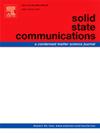Nonlinear near-field microwave probing of Andreev bound states in ultrathin YBa2Cu3O7−x films
IF 2.1
4区 物理与天体物理
Q3 PHYSICS, CONDENSED MATTER
引用次数: 0
Abstract
Boundary surfaces in epitaxial films of high-temperature oxides can host Andreev bound states. At low temperatures, these states should contribute to nonlinear microwave response and strongly enhance it. Using the nonlinear near-field microwave technique, the temperature dependence of the third harmonic power and its anisotropy in the plane have been studied for ultrathin films. We observe a kink on the dependence at temperature . For , the third harmonic power monotonously increases as the temperature decreases. Additionally, the nonlinear microwave response demonstrates a larger contribution when the supercurrent flows along the and axes of the films. Our experimental results indicate that these low temperature features can be associated with the presence of Andreev bound states at the twin boundaries and/or the film edges.
超薄YBa2Cu3O7−x薄膜Andreev束缚态的非线性近场微波探测
高温氧化物外延膜的边界表面可以形成Andreev束缚态。在低温下,这些状态会导致微波非线性响应,并对其产生强烈的增强作用。利用非线性近场微波技术,研究了超薄YBa2Cu3O7−x薄膜三次谐波功率P3ω(T)在(ab)平面上的温度依赖性及其各向异性。在温度Tkink ~ 20−30K时,我们观察到P3ω(T)的依赖性出现了扭结。对于T<;Tkink,随着温度的降低,三次谐波功率单调增加。此外,当超电流沿薄膜的a轴和b轴流动时,非线性微波响应的贡献更大。我们的实验结果表明,这些低温特征可能与孪晶边界和/或薄膜边缘存在Andreev束缚态有关。
本文章由计算机程序翻译,如有差异,请以英文原文为准。
求助全文
约1分钟内获得全文
求助全文
来源期刊

Solid State Communications
物理-物理:凝聚态物理
CiteScore
3.40
自引率
4.80%
发文量
287
审稿时长
51 days
期刊介绍:
Solid State Communications is an international medium for the publication of short communications and original research articles on significant developments in condensed matter science, giving scientists immediate access to important, recently completed work. The journal publishes original experimental and theoretical research on the physical and chemical properties of solids and other condensed systems and also on their preparation. The submission of manuscripts reporting research on the basic physics of materials science and devices, as well as of state-of-the-art microstructures and nanostructures, is encouraged.
A coherent quantitative treatment emphasizing new physics is expected rather than a simple accumulation of experimental data. Consistent with these aims, the short communications should be kept concise and short, usually not longer than six printed pages. The number of figures and tables should also be kept to a minimum. Solid State Communications now also welcomes original research articles without length restrictions.
The Fast-Track section of Solid State Communications is the venue for very rapid publication of short communications on significant developments in condensed matter science. The goal is to offer the broad condensed matter community quick and immediate access to publish recently completed papers in research areas that are rapidly evolving and in which there are developments with great potential impact.
 求助内容:
求助内容: 应助结果提醒方式:
应助结果提醒方式:


